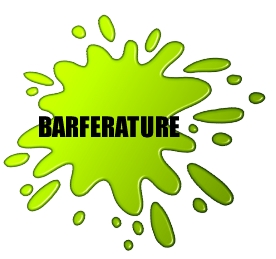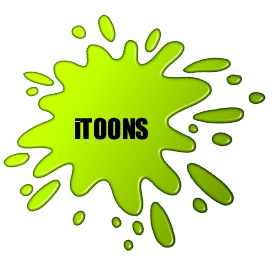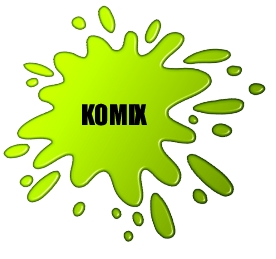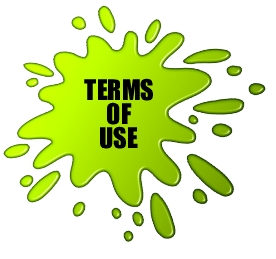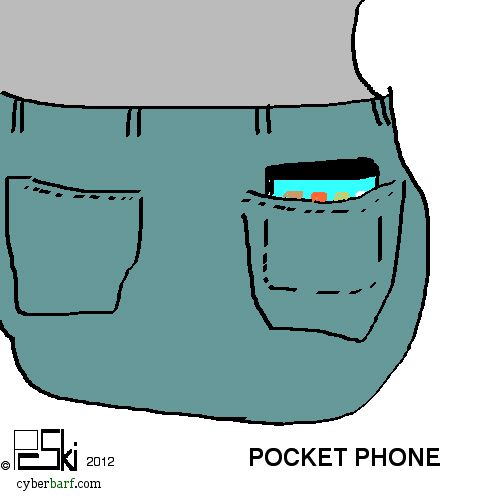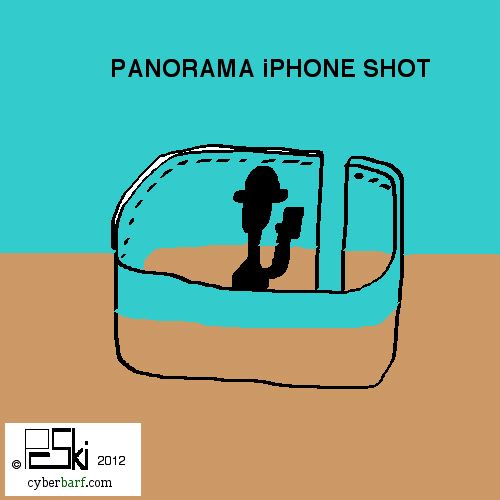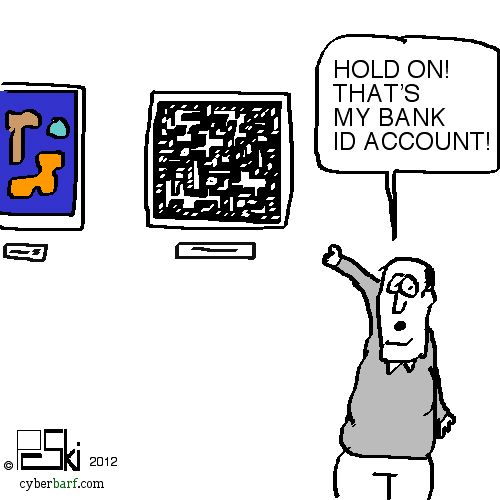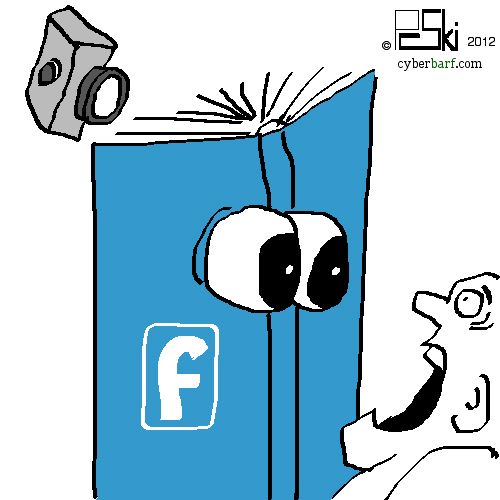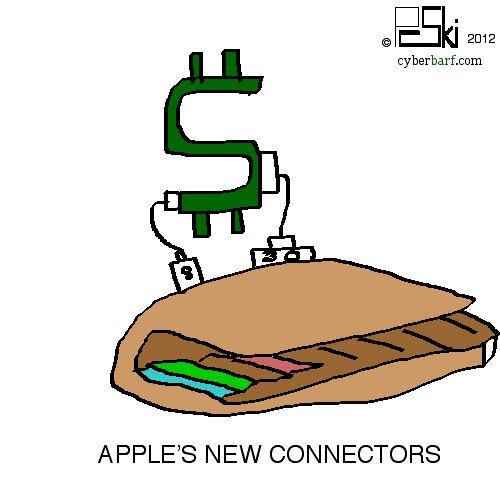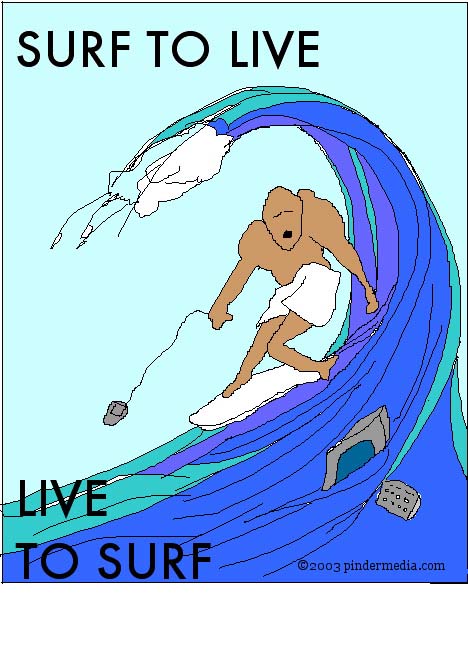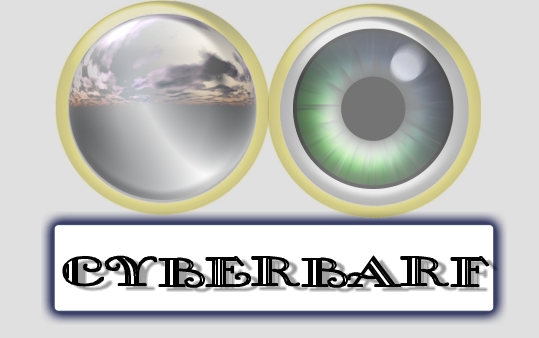
|
BARFETTES
|
cyberbarf.com EXAMINE THE NET WAY OF LIFE OCTOBER, 2012 IN THIS ISSUE: BARFETTES TRICK OR TREAT! PHONE CARRIAGE THE WORK PLACE iTOONS WHETHER REPORT
CYBERBARF T-SHIRTS, MUGS & MORE THANK YOU FOR YOUR SUPPORT! THANK YOUR FOR YOUR CONTINUED SUPPORT.
CYBERBARF
|
|
cyberbarf EXAMINE THE NET WAY OF LIFE |
|
cyberbarf TRICK OR TREAT! ESSAY The pagan holiday of appeasing the spirits once a year by giving them treats has been commercialized into the second biggest holiday in America, Halloween. In a culturally acceptable form of begging, a costumed child appears at the door and asks “Trick or Treat?!” It is the magic command to get free candy. But in earlier days, the homeowner could ask for a clever trick, a song or dance, in order to get a reward. To hear a reply of trick today would be the ultimate bait and switch joke. In ancient Britain and Ireland, the Celtic festival of Samhain eve was observed on October 31, at the end of summer. This date was also the eve of the new year in both Celtic and Anglo-Saxon times and was the occasion for one of the ancient fire festivals when huge bonfires were set on hilltops to frighten away evil spirits. The date was connected with the return of herds from pasture, and laws and land tenures were renewed. The souls of the dead were supposed to revisit their homes on this day, and the autumnal festival acquired sinister significance, with ghosts, witches, hobgoblins, black cats, fairies, and demons of all kinds said to be roaming about. It was the time to placate the supernatural powers controlling the processes of nature. In addition, Halloween was thought to be the most favorable time for divinations concerning marriage, luck, health, and death. It was the only day on which the help of the devil was invoked for such purposes, according to the Encyclopedia Britannica. The pagan observances influenced the Christian festival of All Hallows' Eve, celebrated on the same date. Gradually, Halloween became a secular observance, and many customs and practices developed. In Scotland young people assembled for games to ascertain which of them would marry during the year and in what order the marriages would occur. Many Halloween customs have become games played by children. Immigrants to the U.S., particularly the Irish, introduced secular Halloween customs that became popular in the late 19th century. Mischief-making on this occasion by boys and young men included overturning sheds and outhouses and breaking windows, and damage to property was sometimes severe. In later years, the occasion has come to be observed mainly by small children, who go from house to house, often in costume, demanding "trick or treat" (the treat, often candy, is generally given and the trick rarely played). It was one of those pagan rituals that many organized religions used as a means of converting non-worshippers towards their church and its sacred holidays like All Saints' Day. In modern times, it is the occasion for pranks and for children requesting treats or threatening tricks. Samhain, one of the most important and sinister calendar festivals of the Celtic year. At Samhain, held on November 1, the world of the gods was believed to be made visible to mankind, and the gods played many tricks on their mortal worshipers; it was a time fraught with danger, charged with fear, and full of supernatural episodes. Sacrifices and propitiations of every kind were thought to be vital, for without them the Celts believed they could not prevail over the perils of the season or counteract the activities of the deities. Samhain was an important precursor to Halloween. Since Halloween is a festival that deals with the spirits and moving around in the still of the night where evil lurks, there are many traditional aspects that are hidden in plain sight during the rest of the year. The tradition wearing of masks and disguises important element of inferred tricks on unwise homeowners. A mask is a type of disguise, commonly an object worn over or in front of the face to hide the identity of the wearer. The features of the mask not only conceal those of the wearer but also project the image of another personality or being. The mask has become the symbol of acting companies and theater groups for that very reason. In addition, the idea of carving a scary jack-o'-lantern to be placed on one's doorstep, is another throw back to guard against evil spirits. Since evil spirits can inhabit any object, it was tradition to use gargoyles or other avenging faces to ward off spirits. You often see them built into the architecture of your city; guarding the entrance to public buildings, as part of ornate rooftop terra cotta figurines, or placed right above public drinking fountains. Modern civilizations mold their traditions to meet the needs of their changing culture. Current technology cannot escape the tricks and treats of consumers. TREAT: The new Apple iPhone, touted as the next great smartphone. TRICK: It has upgrades in all of its components and power, but it is not a huge leap in technology. In certain areas, critics have found that the new mapping software buggy and and a downgrade from Google maps. The iodized aluminum case is ultra light, but the trade off is that the case is not scratch proof. But the original iPhone was prone to scratches as well until the iPhone was encased in special glass. The map complaints have to deal with the demand for more precise navigation, better map graphics, and the ability for directions to get around real time traffic. It is like the expectation is perfection so the user does not have to think in processing traffic information to create their own route to avoid jams. TREAT: For some viewers of the lowest common denominator based TV culture, the buffoonery reality shows is must see viewing. TRICK: The “reality” part of those kind of shows is a misnomer. Those shows are highly scripted by producer set ups with staff writers ending with heavily edited post-production to create conflicts. It feeds the illusion of connected culture. The alleged insider view of people living staged lives is supposed to mirror the viewers, to draw them into the click week after week. The premise does not matter: dating, bad room mates, athletic events. Just get a bunch of hyperactive swearing celebrity wannabes in a confined situation and film it day and night. The boring detail of blowing every little thing our of proportion for drama's sake is like the pandering nature of today's 24/7 connected technology. People will blog, tweet or text the mundane aspects of their lives because they are addicted to producing a record of their mundane lives under the illusion that one's life is just as important or interesting as some one on basic cable. TRICK: Inventors and creative people being able to crowd source funds to make their dream projects a reality. TREAT: Consumers can get on the ground floor (and usually at a discount) for a new gadget or technology. It makes those donors part of an exciting team of entrepreneurs working outside the norm of modern business plans and bank loans. The problem is that the crowd funding system has been corrupted by those people not developing a new product, but they are merely using the platform to sell existing inventory to consumers under the guise of the Next Great Thing. Host servers such as Kickstarter have recently started to block and rescind those types of store front retailers from their platform as not being part of the original mission statement. TRICK: Smart phone manufacturers have settled in to a two-year product upgrade cycle to match telecom contracts. TREAT: Consumers have a constant new supply of feature rich new smartphones every year in which to compare and purchase. Now that users expect their phone providers to march to this inflexible schedule, many manufacturers hit the technology wall hard like a marathon runner collapsing after 20 miles. RIM is a good example of the leader in the business enterprise smartphone, with its early avid crackberry adopters, that has now become a footnote in the world of telephone products. But even the best manufacturers, Apple, Samsung, Google, are stressed to think ahead two years while trying to perfect their new feature technologies by artificial consumer deadlines. Those companies have fallen into a trap. As the late Steve Jobs once said, the market does not tell him what he should give consumers. He would decide what products consumers should have to improve their lives.
cyberbarf PHONE CARRIAGE COMMENTARY In just about every smartphone cycle, some engineer loses a prototype device in some bar or restaurant. Why companies allow their employees to take demo phones into the wild is one question. The other is why do people constantly lose their phones in public places? In all its greatness, the smartphone is a difficult partner to human companionship. Take a panoramic view of a public park at any given moment, you will see several people in technology prayer - - - their hands cupped around their smartphone, intensely focused on the screen. It does not matter whether a person's child is dangling precariously from a jungle gym, or someone is about to snatch their purse. The smartphone has the soothing touch in the palms of the user's hand like a a gentle stroke of a dog's neck has a relaxing Zen quality. The average smartphone is about 4.5 inches by 2.5 inches by 3/8th inch. The average user's palm is 3 inches by 3 inches. A smartphone does not hold in one's hand like a glove. The smartphone is an awkward device to carry. It is too big to be put into a shirt pocket. To constricting in a front pants pocket. The average back pocket of a khaki is 4 inches by 4 inches. When you are walking or standing, the back pocket is the only viable choice for a person who needs hands free to eat, drink, talk, shop, or carry other items such as a small child.
Women do have the advantage of sticking their smartphone into their purse or handbag. Business men who wear suit coats have the ability to hide their smartphones in their inner jacket pocket. But with the advent of business casual attire, more men don't wear suits in the work place. So they resort to carrying their phone in their hand. And once they get to a spot, such as their desk, a restaurant table or a bar stool, then instinctively put their phone down on the nearest surface. The alternative is keeping the phone in a back pocket, which is an awkward sit and leads to many phantom "butt calls" to strangers and 911. So are hardware engineer is sitting at bar, having a good time with friends, and after a while he forgets that he set down the new demo phone on the bar. Things get crowded, people jostle for the attention of the bartenders, you move around the bar area - - - and you leave the device alone. That is a temptation to those who are willing to break into cars to steal smartphones. An hour later, the engineer realizes he is missing something; but the smartphone is gone. Employer, very unhappy. Smartphones are one of those devices that are small enough to be easy transport, but a hard device to carry. The alternative of running around with a messenger bag or a phone belt clip screams nerdist geek. In some circles, that is not cool. In other circles, it makes practical sense - - - to take care of things that matter. And for more and more people, their smartphone is all that matters in their lives. It is their lifeline to the Internet It is the quick post to twitter or facebook. It is their navigator. It is their shopping assistant. It is their personal assistant calendar. And less and less, it is a portable telephone. There is nothing wrong with one device replacing paper calendars, address books, note pads or 35mm cameras and home video recorders. But the race to capture the next wave of people coming off their telecom contract cycle is forcing smartphone makers to add more and more features to re-capture the imagination of consumers. It makes the amount of feature overload more important than the true functionality of the core machinery. Hence, people are prone more often than not in the technology prayer stance. For example, Apple's new iPhone 5 has a new feature called the panorama shot. Many digital cameras allow users to take panoramic pictures, usually by the camera software splicing together a series of individual still shots into one elongated view. Apple's new feature claims that the camera will seamless take one steady hand held picture as you move the camera across the horizon. Now, for a photography buff is that cool? Yes, it is. Is it something consumers have been hell-bent demanding? No, not at all.
Smartphone makers carry the burden of innovation from year to year now. The only consumer driven idea is that the public wants something new. New is not necessarily better (take Apple's 3D maps for example: it is a buggy program that will need major software updates to put it on par with the old Google maps). But it is 3D! the salesmen will say. And a certain segment of gadgeteers will agree - - the status of the newest phone is greater than the objective review of the newest phone. But consumers expectations are more advanced than the current technology. Even with good upgrades on the hardware or software of a phone, there will always be critics willing to seize the moment to flame a flaw. Apple's dysfunctional new map program is a prime example of a beta program getting hunted and shot down in the wild. New CEO Tim Cook had to make a public apology and gave users a list of alternative map apps. Even when Apple sells a record number of new phones in the opening weekend, company executives can still be humbled by public comment. But do consumer demands really mean that much to the overall technology experience? For example, who needs a 7 inch tablet game player that also happens to be a smartphone camera? Putting one of those up to your ear to take a telephone call is getting into GET SMART shoe phone territory. Who else gets annoyed when a parent holds an iPad over their head to record their child in the school play? Being new, different, unique in a product life cycle which is being eroded away to 2 to 3 year cycles is a technology pressure cooker. The idea of making smaller devices packed with more computing power and features is going to hit the wall in the near future, unless someone can port the Star Trek pin communicator as one's phone or LaForge's glasses as video telephone communications devices. There may be a time and place for everything. In a dark theater, it looks like a field of distant camp fires because just about everyone has their phone on sitting in their laps. Restaurants have gone to prohibit cell phone interruptions in the dining room. The reason why people are so attached to their smartphones is a simple, basic instinct. People have to carry their smartphones around, and they cradle it like a baby. It may be a subconscious nurturing gene that triggers the undivided loyalty and addictive behavior to Android, or iPhone. The phone is literally growing up as the years go by; it can now talk to you, interact with you, give you recommendations and driving directions. It will always be there to pal around with you. It is another step in the chain of advances that slowly restrict the interpersonal one-on-one communication that was only a generation removed from today.
cyberbarf THE WORK PLACE ARTICLE There is a perception that we live in the golden age of technology. The release of the latest smart phones put more and more information into the palms of the average person. Supercomputing power that was confined to a few universities a generation ago are now common place. It would be almost techno-blasphemy to say that today's electronic marvels are merely implementation of modern takes on old ideas. Simply look around your typical office. What are the ten most used, most ordered, or most useful tools in a modern business office? These items are almost transparent; taken for granted n a daily basis. PAPER CLIPS. A simple twisted thin wires are found next to every duplication station and desk drawer in an office. The genius of twisting wire to temporarily hold together paper is not a new invention. It was created in the United States in 1899 AD. STAPLER. The device to securely attach pieces of paper together is also an office necessity. It was created in France in 1866 AD. TELEPHONE. Every school child is taught the origins of the telephone. Alexander Graham Bell and Thomas Edison duking it out over who could patent it first. The telephone as a device of sending information over long distances through wires dates back to 1876 AD. The advancements of telecom technology, including the Internet global network, still use the foundation of telephone systems. PAPER. Every retail store in America will sell you all shapes, sizes and colors of paper. Handmade paper was invented to help in record keeping and transactions. It is believed that the first notable use was in 105 AD in the Middle East, but other scholars believe that the Chinese invented paper making in 140 BC. INK. For what is paper without a method of recording information? The use of ink pigments from plants or animal fluids has been around since the dawn of mankind if you use stone age man's cave paintings as a starting point. Scholars point to the ink in acceptable use in 900 AD, while others look to the first commercial black inks in 1200 AD as the starting point for modern ink. However, the Chinese may have invented ink as far back as 2697 BC. ELECTRICITY. Again, school children learn of Ben Franklin investigating natural electricity by flying his kite in a lightning storm. But the first acknowledgment and production of electricity goes back to 600 BC with the discovery of static electricity charges. The first modern light bulb was invented in 1879 AD. WHITE-OUT CORRECTION FLUID. Human beings make mistakes. In the process of creating official documents, a mistake by a scribe would mean re-doing the document all over from scratch. As business demanded more efficient and faster means of creating communications and correspondence, typographical errors were common. In 1924 AD, a woman in Texas who described herself as a bad typist, claims to have invented in her kitchen a white fluid that could be applied over a ink impression and re-typed over by a pen or typewriter stroke. In 1957 AD, her idea went into commercial production as liquid paper. Any office which still has manual typewriters to fill out government or official forms needs to have a bottle or two of correction fluid. COPY MACHINE. The idea of making a duplicate copy of a document used to mean that the scribe had to literally manually copy the document on a new piece of paper. The first mechanical copy machine is credited to steam machine inventor James Watt in 1780 AD. In 1876 AD, Thomas Edison is credited with creating a machine suitable for business use. But the acceptance of the technology took off in 1938 AD with the development of xerography. FILE FOLDERS. Many people take for granted envelopes and file folders. However, originally if you wanted an envelope, you had to make one yourself. Scholars have found the earliest envelope makers were the Babylonians. The first machine to make envelopes or folding papers to file jackets was in England in 1840 AD. The first vertical file cabinet was invented in 1898 AD. Prior to that time, papers were stored in ordinary desk furniture draws, stacked on top of each other, which made access the right file tedious. CALCULATORS. The first known calculator dates back to the Chinese abacus in 1300 BC. The first mechanical calculator was Pascal's calculating machine of 1642 AD. So the modern office tools date back thousands of years. But most office workers have no idea that their modern conveniences have ancient roots.
|
|
THE PINDERMEDIA STORE IS FULL OF FUN T-SHIRTS CLOTHES, HATS AND OTHER ITEMS . FUN . . . . VALUE . . .. FUN . . . . VALUE! GO FOR IT!
THE POLITICAL SEASON IS HERE! NEW T-SHIRTS ON SALE!
SUPPORT cyberbarf VISIT THE CYBERBARF STORE! Prices may vary depending on sales, allotments, inventory. |
|
iToons
|
|
cyberbarf THE WHETHER REPORT |
cyberbarf STATUS |
| Question: Whether new upgrades in smartphone cameras will make single use digital cameras obsolete? |
* Educated Guess * Possible * Probable * Beyond a Reasonable Doubt * Doubtful * Vapor Dream |
| Question: Whether European economic and fiscal troubles will lead to a bursting of America's new tech bubble? |
* Educated Guess * Possible * Probable * Beyond a Reasonable Doubt * Doubtful * Vapor Dream |
| Question: Whether Apple's agency model for selling e-books will survive government anti-trust challenges? |
* Educated Guess * Possible * Probable * Beyond a Reasonable Doubt * Doubtful * Vapor Dream |
|
cyberbarf EXAMINE THE NET WAY OF LIFE |
I don't know the key to success, but the key to failure to is trying to please everybody. Bill Cosby |
|
SUMMER IS COMING FAST. SURF'S UP WITH THIS CLASSIC T-SHIRT!
FEATURING: THE REAL NEWS IMPACT EDITORIAL CARTOONS WRIGLEYVILLE WAR POLITICS ENDORPHIN RUSH THE DARK ABYSS RANDOM ELECTRONS SPECIALS
FEATURING: THE REAL NEWS ARCHIVES CARTOONS MADAME'S TEA HOUSE THE BAR EXPLORE THE CITY SCAPE UNDER CONSTRUCTION SURPRISES ESTORE SPECIALS
|
|
cyberbarf
THE STEAM PUNK SPECIAL EDITION featured new Music from Chicago Ski & the (audio) Real News: (mp3/4:14 length)
EXAMINING THE NET WAY OF LIFE cyberbarf™ distributed by pindermedia.com, inc. |
RERUNS HAVE RETURNED
TO CABLE TV.
NEW INSIGHTS.
NEW THEORIES.
Recaps
at
LOSTHEORY
cyberbarf
Distribution ©2001-2012 pindermedia.com, inc.
All Ski graphics, designs, cartoons and images copyrighted.
All Rights Reserved Worldwide.
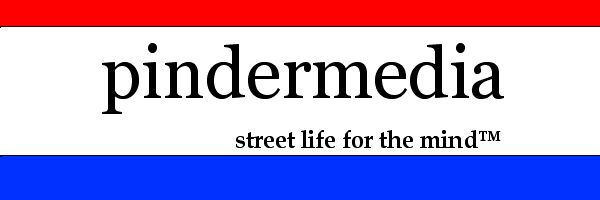
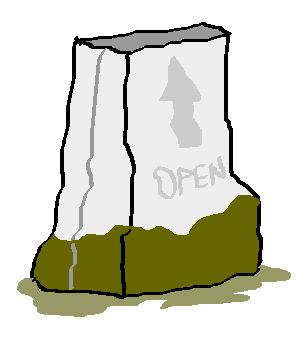
 LOCK
DOWN: The new Wii U console will come with a region locked feature.
This is the same type of copy protection used in DVDs and video players.
The advance in the scope of the humble game controller into a full
function set top internet cable box is continuing, as many manufacturers
want to become an all-in-one living room communication hub.
LOCK
DOWN: The new Wii U console will come with a region locked feature.
This is the same type of copy protection used in DVDs and video players.
The advance in the scope of the humble game controller into a full
function set top internet cable box is continuing, as many manufacturers
want to become an all-in-one living room communication hub.

